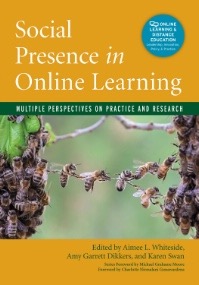teaching strategies
Select an item by clicking its checkbox
Trauma is like a mirror that we don’t want to look into. It captures us at our worst angles. It accentuates what we want minimized and overlooks what we wish to be prominent. In trauma, we see projected the unwanted aspects of our realities in such a startling way ...

Social Presence in Online Learning - Multiple Perspectives on Practice and Research
Date Reviewed: December 12, 2017
As post-secondary institutions, theological schools continue to participate in various forms of online learning, and the criticism (or question), “It’s not really the same as being in a classroom with a real instructor” is commonly heard. The simple reply to this concern is the concept of social presence. Starting with the initial definition of social presence from Short, Williams, and Christies (1976), this compilation of articles attempts to summarize the historical perspectives and present the current state of discussion, recognizing the constant updating of online course options.
The authors successfully present the historical perspectives, grouping them in three broad categories – as technologically facilitated, as learners’ perceptions, and as critical literacy. However, the chronological and developmental approach leaves the reader realizing the earlier chapters have minimal application to current teachers and learners since the understanding of social presence and the technology used have changed so dramatically. The initial discussions about social presence whether through computer-mediated communication or later within the community of inquiry framework were informative, but the reader quickly realizes that the later frameworks and models have improved. Thus the earlier discussions in the book are of little value for today’s teaching-learning environment. In essence, only the last section is relevant, except as historical background.
The editors demonstrate their breadth of knowledge of the literature and are involved with and connected to the latest research in social presence. A useful chapter (11), “Cultural Perspectives in Social Presence,” provides valuable guidelines for communicating effectively in a multi-cultural learning context. Multiple examples explain how one subset of students find an online learning activity contributes positively to social presence while those of another culture find it impacts social presence negatively. Variations in anonymity, informal chat, self-disclosure, trust building, and conflict resolution are considered. The chapter concludes with useful tips for monitoring and mediating communication which could be misunderstood because of cultural differences.
Likewise, various practices for building social presence into discussions, feedback, and interactions are shared throughout the book. The literature reviewed includes a range of educational levels from K-12 and post-secondary as well as a range of disciplines. The final section provides interesting chapters (17 and 18) about the future of online learning and incorporates social presence into various models of instruction. They suggest social media tools enable instructors to incorporate cohesive and affective elements into courses to enhance social presence. The authors conclude, “Never stop learning because life never stops teaching” (210).
The information shared is relevant for any faculty member teaching online, including theological and religious studies professors. While the final chapters contain valuable tips as noted above, I cannot recommend the book as a whole since it is predominantly a historical overview of the concept of social presence. Though it contains various up-to-date strategies in the closing chapters, it was tedious for the reader to sift through the detailed literature for meaningful insights.
The car service arrived at my house. I grabbed my purse, suitcase, and briefcase and hurried out the door making sure it was locked behind me. As scheduled, we stopped to pick up a colleague who was also attending the conference in Toronto, Canada. Driving east on Highway 78 and almost ...
As finals week draws near, Dr. Roger Nam of George Fox University, Dr. Eric Barreto of Luther Seminary, and Dr. Kate Blanchard of Alma College discuss how they, as teachers and educators of theology and religion, prepare to give final exams.

Small Teaching: Everyday Lessons from the Science of Learning
Date Reviewed: November 30, -0001
James Lang has written yet another immensely valuable book for post-secondary faculty. Using the analogy of “small ball” from baseball, the author provides classroom activities requiring only a few minutes that can easily be incorporated into a course sporadically or regularly to improve learning. Each strategy is based on the latest research about the human brain, and Lang has witnessed their “positive impact in real-educational environments” (7).
The strengths of the book are numerous. First and foremost, it accomplishes the stated purpose. In each of the nine chapters, Lang explains the theory behind the learning principle, describes how the theory has been carried out in classroom models, and then summarizes the principles common in each model. Within the models, the reader finds activities that teachers can incorporate into any class and use randomly or repeatedly that enableing students to learn effectively.
Second, each learning activity is transferable across academic disciplines. For example, while discussing “predicting,” the initial research example is from the field of language learning. Lang then applies the principles to his discipline of teaching literature, before concluding with a kinesthetic example of learning an athletic skill. Additionally, Lang recognizes the increasing frequency of teaching and learning online. He also notes students’ access to social media and suggests ways to use the principles and activities of online teaching and social media in a non-traditional classroom format. Finally, while the focus is on in-class actions that take minimal time, he does identify how specific teaching concepts can be incorporated into course planning and the syllabus.
The book is well-organized, not only in its presentation but in the ordering of learning from knowledge acquisition to understanding to learning inspiration (motivation), with three strategies explained in each section. Each concept and activity is well-supported by research noted in a full bibliography. For example, in discussing retrieving, Lang gives examples of opening or closing questions an instructor can use in the first or last five minutes of class that will prove effective for short-term and long-term recall, in light of a variety of studies. Where there are questions about the validity of an idea or activity, Lang acknowledges the issues and interacts fairly with contrary opinion. In short, it is hard to find a negative with this book.
Because each chapter is follows the pattern of theory, model, then principles, a theology or religious studies teacher can easily take the knowledge or concepts they desire to teach and adapt them to any of the teaching strategies.
From a rookie faculty member experiencing challenges midway through a course to an experienced professor looking to improve student learning in a well-developed curriculum, there is something in Small Teaching for everyone. If your college cannot attend one of Lang’s professional development sessions, I would recommend academic deans purchase the book for faculty and together they could work through each chapter.

